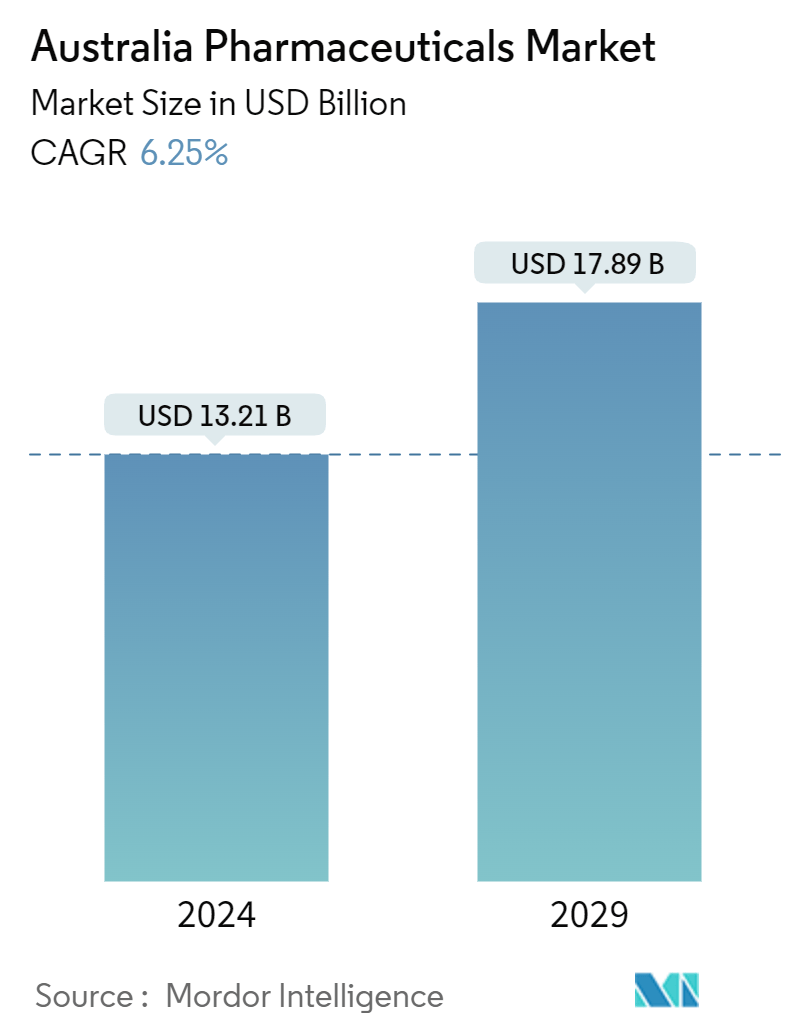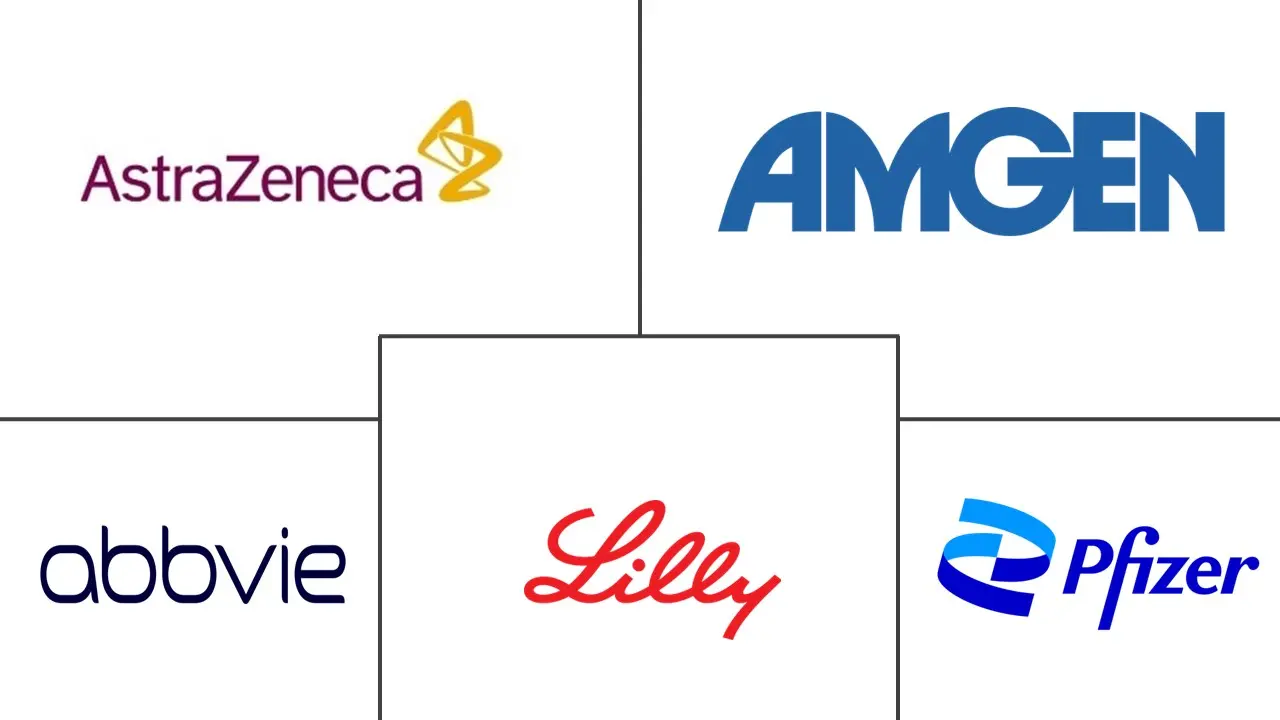Market Size of Australia Pharmaceuticals Industry

| Study Period | 2019 - 2029 |
| Base Year For Estimation | 2023 |
| Market Size (2024) | USD 13.21 Billion |
| Market Size (2029) | USD 17.89 Billion |
| CAGR (2024 - 2029) | 6.25 % |
| Market Concentration | Medium |
Major Players
*Disclaimer: Major Players sorted in no particular order |
Australia Pharmaceutical Market Analysis
The Australia Pharmaceuticals Market size is estimated at USD 13.21 billion in 2024, and is expected to reach USD 17.89 billion by 2029, growing at a CAGR of 6.25% during the forecast period (2024-2029).
The COVID-19 pandemic had a significant impact on the market studied in Australia. Many companies received approval for their vaccines against the Sars-CoV-2 virus and focused their research and development on therapeutics against COVID-19. For instance, in January 2021, the Therapeutic Goods Administration approved the COVID-19 vaccine developed by Pfizer and BioNTech. In addition, the Australian government signed nearly four agreements and invested around AUD 3.3 billion to support the supply of vaccines in the country. Furthermore, the country invested around AUD 363 million in research and development activities related to the prevention and treatment of COVID-19. Such developments accelerated market growth during a pandemic. Furthermore, the Australian Government has convened a large group of clinical experts to form the National COVID-19 Clinical Evidence Taskforce. The role of the taskforce is to create evidence-based Australian guidelines for the clinical care of people with COVID-19. The Therapeutic Goods Administration (TGA) approved Tixa Genmab and ciljevima (Evoshield) in December 2021 and Sotrovimab (Xevudy) in August 2021 for COVID-19 treatment. Hence, it is observed that the COVID-19 pandemic had a significant impact on the market studied.
The major factors likely to drive market growth during the forecast period are the growing burden of chronic diseases and the rising geriatric population, along with the rising investments in research and development expenditure for novel therapeutics in Australia. According to Australian Bureau of Statistics data updated in March 2022, over three-quarters, i.e., 78.6% of Australians, had at least one long-term health condition in 2021, while nearly half, 46.6% or 11.6 million, had at least one chronic condition. Thus, increasing chronic diseases and a high demand for pharmaceutical products are expected to promote market growth. Furthermore, the burden of diabetes has also increased in the country. As per the data in the International Diabetes Federation's 2021 report, there were about 1.5 million people with diabetes in Australia in 2021, and their number is expected to increase to 1.9 million by 2045. Thus, the demand for pharmaceuticals for diabetes treatment and management is expected to increase over the years in Australia, which is expected to boost growth in the pharmaceuticals market in the country.
Additionally, key strategies adopted by major market players, increased investment, and rising research and development activities will also contribute to market growth. For instance, in June 2022, diabetes-focused biotech player Dimerix entered into a partnership agreement with the Australian Centre for Accelerating Diabetes Innovations (ACADI) to conduct a clinical trial of its oral medical product DMX-200 in diabetic kidney disease patients. Positive results from such studies will boost their demand, hence boosting the pharmaceutical manufacturing process and thereby driving the market during the study period. Thus, the above-mentioned factors are expected to positively contribute to the market's growth over the study period.
However, strict regulatory guidelines for product approvals are expected to hinder market growth.
Australia Pharmaceutical Industry Segmentation
As per the scope of this report, pharmaceuticals are referred to as prescription and non-prescription drugs. These medicines can be bought by an individual with or without the doctor's prescription and are safe for consumption for various illnesses with or without the doctor's consent. The Australia Pharmaceuticals Market is segmented by ATC/Therapeutic Class (Alimentary Tract and Metabolism, Blood and Blood Forming Organs, Cardiovascular System, Dermatologicals, Genito Urinary System and Sex Hormones, Systemic Hormonal Preparations, Anti-infectives for Systemic Use, Antineoplastic and Immunomodulating Agents, Musculoskeletal System, Nervous System, Antiparasitic Products, Insecticides, and Repellents, Respiratory System, Sensory Organs, and Other Therapeutic Classes), Drug Type (Branded and Generic), and Prescription Type (Prescription Drugs (Rx) and OTC Drugs). The report offers the value (in USD million) for the above segments.
| By ATC/Therapeutic Class | |
| Alimentary Tract and Metabolism | |
| Blood and Blood Forming Organs | |
| Cardiovascular System | |
| Dermatologicals | |
| Genito Urinary System and Sex Hormones | |
| Systemic Hormonal Preparations | |
| Anti-infectives for Systemic Use | |
| Antineoplastic and Immunomodulating Agents | |
| Musculoskeletal System | |
| Nervous System | |
| Antiparasitic Products, Insecticides, and Repellents | |
| Respiratory System | |
| Sensory Organs | |
| Other Therapeutic Classes |
| By Drug Type | |
| Branded | |
| Generic |
| By Prescription Type | |
| Prescription Drugs (Rx) | |
| OTC Drugs |
Australia Pharmaceuticals Market Size Summary
The Australian pharmaceutical industry is poised for significant growth over the forecast period, driven by an increasing burden of chronic diseases and a rising geriatric population. The market has been notably influenced by the COVID-19 pandemic, which accelerated developments in vaccine and therapeutic approvals, significantly impacting market dynamics. The government's substantial investments in vaccine supply and research and development for COVID-19 treatments underscored the sector's responsiveness to public health challenges. The demand for pharmaceuticals, particularly for chronic conditions like diabetes, is expected to rise, fueled by the growing prevalence of such diseases. This demand is further supported by strategic partnerships and clinical trials aimed at developing novel therapeutics, which are anticipated to bolster the pharmaceutical manufacturing process in Australia.
The market landscape is characterized by a competitive environment with major players like Abbvie Inc., Amgen Inc., Pfizer Inc., AstraZeneca, and Eli Lilly and Company leading the charge. These companies are actively engaging in acquisitions and joint ventures to strengthen their market positions. The prescription drugs segment is expected to maintain a significant share, driven by technological advancements in prescription processes and the launch of new drugs. Additionally, the generic drugs segment is witnessing robust growth due to their cost-effectiveness and supportive government policies, including agreements facilitating easier market access for foreign pharmaceutical companies. The continuous introduction of generic medications, such as the recent launch of Lacosamide for epilepsy treatment, is expected to further enhance the segment's growth trajectory in Australia.
Australia Pharmaceuticals Market Size - Table of Contents
-
1. MARKET DYNAMICS
-
1.1 Market Overview
-
1.2 Market Drivers
-
1.2.1 Rising Geriatric Population and Increasing Investments in the Sector
-
1.2.2 Rising Incidence of Chronic Diseases such as CVD and Diabetes
-
-
1.3 Market Restraints
-
1.3.1 Stringent Regulatory Scenario
-
-
1.4 Porter's Five Forces Analysis
-
1.4.1 Threat of New Entrants
-
1.4.2 Bargaining Power of Buyers/Consumers
-
1.4.3 Bargaining Power of Suppliers
-
1.4.4 Threat of Substitute Products and/ or Services
-
1.4.5 Degree of Competition/Intensity of Competitive Rivalry
-
-
-
2. MARKET SEGMENTATION (Market Size by Value - in USD Million)
-
2.1 By ATC/Therapeutic Class
-
2.1.1 Alimentary Tract and Metabolism
-
2.1.2 Blood and Blood Forming Organs
-
2.1.3 Cardiovascular System
-
2.1.4 Dermatologicals
-
2.1.5 Genito Urinary System and Sex Hormones
-
2.1.6 Systemic Hormonal Preparations
-
2.1.7 Anti-infectives for Systemic Use
-
2.1.8 Antineoplastic and Immunomodulating Agents
-
2.1.9 Musculoskeletal System
-
2.1.10 Nervous System
-
2.1.11 Antiparasitic Products, Insecticides, and Repellents
-
2.1.12 Respiratory System
-
2.1.13 Sensory Organs
-
2.1.14 Other Therapeutic Classes
-
-
2.2 By Drug Type
-
2.2.1 Branded
-
2.2.2 Generic
-
-
2.3 By Prescription Type
-
2.3.1 Prescription Drugs (Rx)
-
2.3.2 OTC Drugs
-
-
Australia Pharmaceuticals Market Size FAQs
How big is the Australia Pharmaceuticals Market?
The Australia Pharmaceuticals Market size is expected to reach USD 13.21 billion in 2024 and grow at a CAGR of 6.25% to reach USD 17.89 billion by 2029.
What is the current Australia Pharmaceuticals Market size?
In 2024, the Australia Pharmaceuticals Market size is expected to reach USD 13.21 billion.

